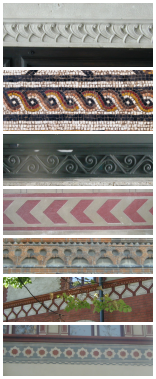 The word "frieze" in mathematics defines a plane figure whose
symmetry group (that is the set of all those transformations of the plane that leave distances unchanged and map the figure onto itself)
contains translations, but only those which point in one direction and in fact are all multiples of a base translation.
The word "frieze" in mathematics defines a plane figure whose
symmetry group (that is the set of all those transformations of the plane that leave distances unchanged and map the figure onto itself)
contains translations, but only those which point in one direction and in fact are all multiples of a base translation.
This figure is thus unlimited (we can apply the same translation 2, 3, 1000 times and the figure will remain unchanged). When we say that a picture on a piece of paper, on a monument or on a computer screen is a "frieze" we are assuming with our imagination that the figure is extending beyond the limit of the page, the wall or the screen.
The symmetry groups of a given 'frieze' are seven and only seven. We list them here assigning to each of them a symbol and the name of some transformations. The symbol will be explained in the sequel. The names of transformations are "evocative", that is they refer to the transformations that best "characterize" the group (e.g. all groups in fact contain translations, thus it would be redundant to include them each time). The other transformations of the given group can be obtained by composing the basic transformations we indicate here.
 | p111 |
| translations | |
 | p112 |
| rotations | |
 | p1a1 |
| glide-reflections (that is the composition of a translation and a reflection, whose axes is parallel to the translation vector) | |
 | p1m1 |
| horizontal reflections (that is with axes parallel to the translation vector) | |
 | pm11 |
| vertical reflections (that is with axes perpendicular to the translation vector) | |
 | pma2 |
| vertical reflections and rotations | |
 | pmm2 |
| vertical reflections and horizontal reflections |
The symbol on the left indicates the type of group, it comes from crystallography; it is composed by 4 characters by means of the following rules:
- The first character is always p
- The second character can be 1 or m: (as in mirror).
It is "m" when the symmetry group of the given figure contains vertical reflections:
it is "1" in all other cases:


pm11 pma2 pmm2




p111 p112 p1a1 p1m1 - The third character can be "1" or "m" or "a".
It is "m" if the symmetry group of the figure contains a horizontal reflection:
it is "a" if the symmetry group of the figure contains a glide-reflection with a horizontal line of reflection.

p1m1 pmm2
it is "1" in all other cases

p1a1 pma2



p111 p112 pm11 - The fourth character can be 1 or 2: it is 2 if the symmetry group of the figure contains rotations of 180°
It is "1" in all other cases


p112 pma2 pmm2




p111 p1a1 p1m1 pm11
You can find some interactive animations about friezes in Draw your own frieze and Recognize a frieze.